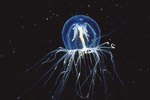
Starfish are not actually fish; they're marine animals from taxonomic family Echinodermata. Three distinct types of starfish or sea stars exist, but thousands of species exist within those types. Starfish don't swim, but they do manage to move along the sea floor or on reefs by an unusual process of locomotion.
Common Stars, Brittle Stars and Feather Stars
Common starfish come in a variety of sizes, colors and shapes but most have short arms. Some have more than five. Brittle stars have long, slender arms that are fragile. The arms break off easily but then grow back just as easily. Some specimens have up to 20 or more arms. The feather starfish has arms that resemble feather tendrils. These arms are long, slender, often curly and hairy. Starfish reproduce two ways, asexually, by breaking off limbs that grow into new stars, and sexually, with each star being both male and female.
Walking on Water
Starfish move by gliding along on the bottom of the sea or the surface of the reef by using a complex water jetting system that shoots water through tunnels in the arms and out through tiny tubes on the bottoms of the arms, which move in waves to move the animal.
Flexing the Tube Foot
A starfish has an opening near the outer edge of the central body called a madreporite. This pore sucks water into small ducts called canals. There are three types. The ring canal carries water from the madreporite to each of the arms, where the radial canals take it down to the lateral canals, which push water into an ampulla, where the water is stored. The water is pumped out of the ampulla and through tube feet, causing the flexion of a section of tube feet on the underside of an arm.
Relaxing the Tube Foot
When the water stops pumping, the tube foot relaxes again. The pump-and-relax action causes the tube feet to move in waves by rows, which enables the starfish to glide on the sea floor. The process becomes more fascinating: The sea star changes direction by pumping water through certain tube feet instead of others, which causes the animal to move left, right or backward. The starfish doesn't swim through the water but uses water to move itself along a surface.
References
Photo Credits
-
John Foxx/Stockbyte/Getty Images




